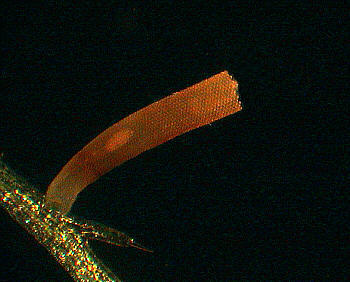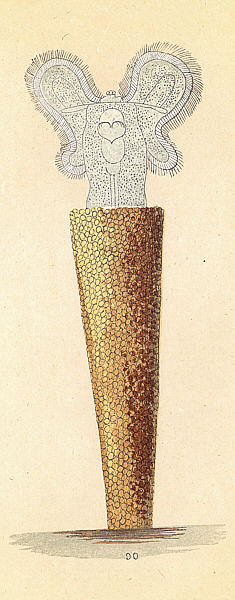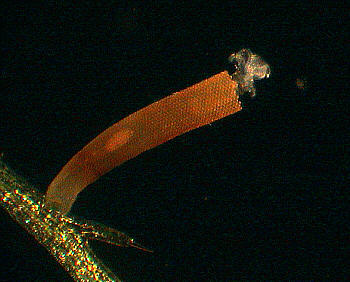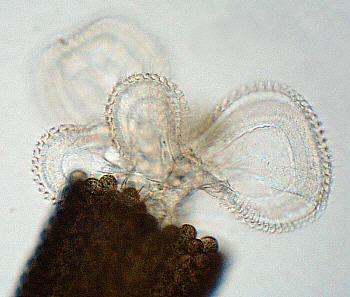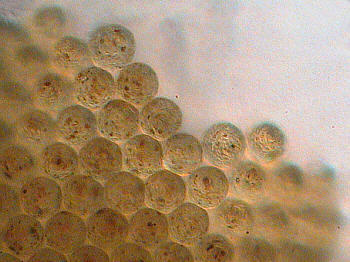Recently I took a water sample from a small pond full of water plants, about 40 km north-east of Munich. I put the glass on a window-sill and forgot about this tiny universe for a few weeks. Later on, in one of those scarce moments of complete inactivity I remembered the sample and simply looked at it with the naked eye. After some time I noticed a few small brown sticks, apparently more than 1 mm long, protuding perpendicularly from the branches of the water plants. A closer examination of the brown sticks under the microscope (see figures below) revealed that the sticks are in fact tubes, housings of rotifers, probably of the famous species Floscularia (Melicerta) ringens. The term 'Floscularia' indicates that this group of rotifer species resembles small flowers or blossoms.
Melicerta ringens, a beautiful organism, can be found in the microscopic literature very often. E.g. H.J. Slack published an image of it in his book 'Marvels of pond Life', ca. 1900.
As my favourite microscopic organisms are water bears (see footnote) I have only a very modest knowledge about rotifers in general and even less information about this particular species, but nevertheless I thought that it might be a good idea to share some images and video clips with you in 'Micscape'.
When the rotifer peeps out of its housing, most of the body is still protected by the tube.
Even the slightest disturbance or movement in the environment causes an extremely quick retraction of the shy animal back into the tube.
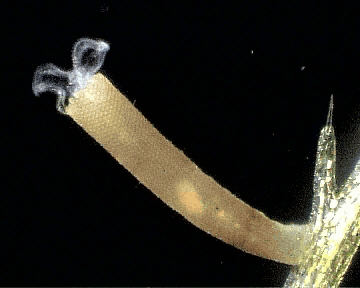
Click image for an avi format video clip (330 kbytes).
(See footnote, if the avi doesn't play).But when left in peace for a minute or longer the four 'rotating wheel' lobes reveal their fascinating motion.
Apparently it functions as a perfect food collection machine and at the same time it is a kind of puzzling, hypnotic cinema for us humans, even more impressive when watched in dark field illumination.
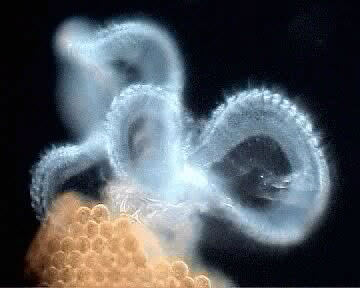
Click image for an avi format video clip (870 kbytes).
(See footnote, if the avi doesn't play).The rotating wheel lobes have a further function. They serve to collect material to build up the housing of Floscularia, which is made out of brownish pills. Those pills are formed one by one by the microscopic artist just out of minute amounts of mud and glue. They are combined to form a housing of impressive regularity and symmetry, the geometry of which seems to be superior to most snow and clay constructions by Homo sapiens.
Slack describes this work as follows: 'Melicerta ringens … is at once brickmaker, mason and architect and fabricates as pretty a tower as it is easy to conceive. …
Pellet by pellet, or brick by brick does the Melicerta build her house, which widens gradually from the foundation to the summit, and every layer is placed with admirable regularity'.
All comments to the author Martin Mach are welcomed.
Footnotes:
Visit the author's web-site www.tardigrades.com, and the German language website www.baertierchen.de which celebrate the marvels of water bears and include stunning video clips.Playing avi video clips
If your web browser doesn't have a plug-in that supports avi movie clips, the free RealOneTM media player can be downloaded from uk.real.com.
